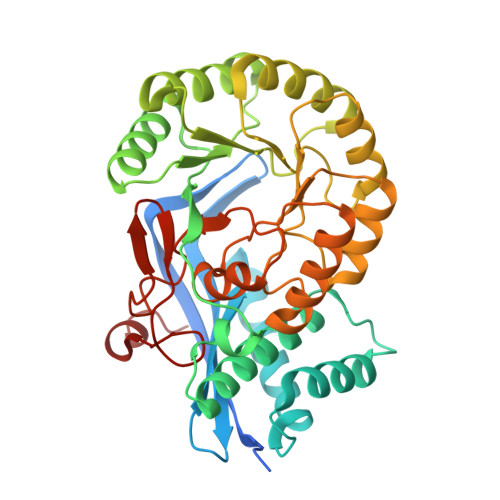Structure of mandelate racemase with bound intermediate analogues benzohydroxamate and cupferron.
Lietzan, A.D., Nagar, M., Pellmann, E.A., Bourque, J.R., Bearne, S.L., St Maurice, M.(2012) Biochemistry 51: 1160-1170
- PubMed: 22264153
- DOI: https://doi.org/10.1021/bi2018514
- Primary Citation of Related Structures:
3UXK, 3UXL - PubMed Abstract:
Mandelate racemase (MR, EC 5.1.2.2) from Pseudomonas putida catalyzes the Mg(2+)-dependent interconversion of the enantiomers of mandelate, stabilizing the altered substrate in the transition state by 26 kcal/mol relative to the substrate in the ground state. To understand the origins of this binding discrimination, we determined the X-ray crystal structures of wild-type MR complexed with two analogues of the putative aci-carboxylate intermediate, benzohydroxamate and Cupferron, to 2.2-Å resolution. Benzohydroxamate is shown to be a reasonable mimic of the transition state and/or intermediate because its binding affinity for 21 MR variants correlates well with changes in the free energy of transition state stabilization afforded by these variants. Both benzohydroxamate and Cupferron chelate the active site divalent metal ion and are bound in a conformation with the phenyl ring coplanar with the hydroxamate and diazeniumdiolate moieties, respectively. Structural overlays of MR complexed with benzohydroxamate, Cupferron, and the ground state analogue (S)-atrolactate reveal that the para carbon of the substrate phenyl ring moves by 0.8-1.2 Å between the ground state and intermediate state, consistent with the proposal that the phenyl ring moves during MR catalysis while the polar groups remain relatively fixed. Although the overall protein structure of MR with bound intermediate analogues is very similar to that of MR with bound (S)-atrolactate, the intermediate-Mg(2+) distance becomes shorter, suggesting a tighter complex with the catalytic Mg(2+). In addition, Tyr 54 moves closer to the phenyl ring of the bound intermediate analogues, contributing to an overall constriction of the active site cavity. However, site-directed mutagenesis experiments revealed that the role of Tyr 54 in MR catalysis is relatively minor, suggesting that alterations in enzyme structure that contribute to discrimination between the altered substrate in the transition state and the ground state by this proficient enzyme are extremely subtle.
- Department of Biological Sciences, Marquette University, Milwaukee, Wisconsin 53201-1881, United States.
Organizational Affiliation:


















